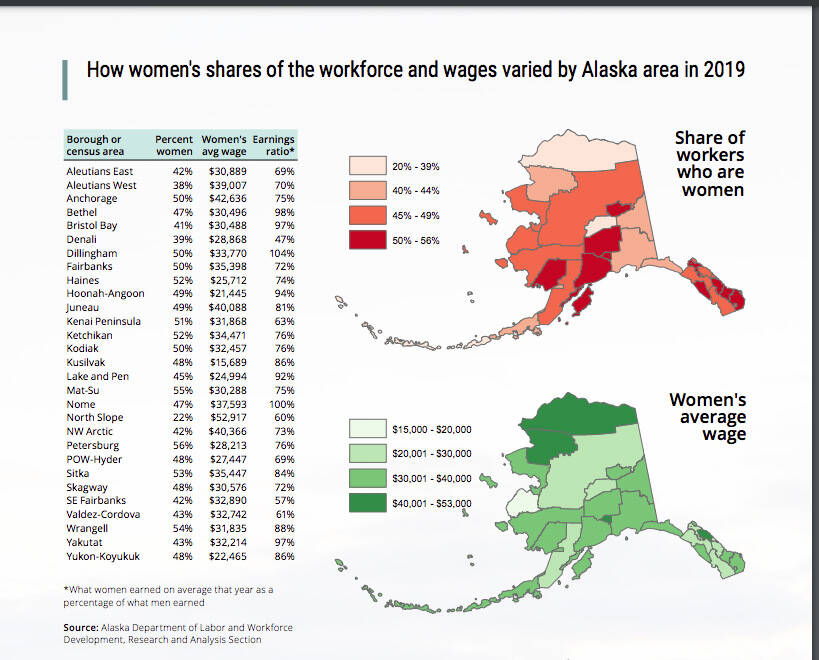Women in Alaska earned, on average, about 72% of what men earned in Alaska in 2019.
That’s according to the October issue of Trends, a publication distributed monthly by the Alaska Department of Labor and Workforce Development.
The publication broke down the earnings ratio — what women earned as a percentage of what men earned — in regions across the state.
Historical data show that the earnings ratio in Alaska has increased over the last 30 years, from 62% in 1990 to 72% in 2019. There are varying levels of disparity in different regions of the state.
The earnings ratio was highest in Dillingham and Nome, where the ratio was actually over 100% in 2019, meaning women earned more than men on average that year. The ratio was lowest in southeast Fairbanks and Denali, where the ratios are 57% and 47%, respectively. On the Kenai Peninsula, the earnings ratio is 63%, which ranks it 25 out of 29 Alaska regions.
A woman in Alaska made about $38,000 on average in 2019, whereas a man in Alaska made about $52,000. A woman on the Kenai Peninsula made $31,868 on average in 2019.
The survey found that the wage gap was smallest in Alaska’s urban areas, where women and men had roughly equal representation in the workforce, about 49% and 51% in 2019, respectively. That representation did not translate to wages, where women took home about 40% of wages in 2019 compared to men, who took home about 60% of wages in the same year.
“Although the genders participate in the workforce at nearly equal rates, men earn more in almost 80 percent of Alaska’s occupations and at every age and educational level,” the report says.
But there are several variables impacting how much money someone makes at their job, including education, training, discrimination and hours worked.
While women were found to work in all Alaska industries, the report says, almost 25% work in health care and social assistance, with the second largest industries being in local government, including public schools, and retail. That’s compared to the participation of female workers in industries with “high paying wages,” such as oil and gas, where the participation rate is 2.5%.
Even in industries where women account for most of the workforce they do not always take home the same proportion of wages.
“In all major industry groups, women earn proportionally less than men,” the report says. “Although women make up 76 percent of health care and social assistance, for example, they bring home 70 percent of the wages.”
To compile the data used for the report, the Alaska Department of Labor and Workforce Development matched data taken from Alaska’s unemployment insurance program with demographic data from Alaska Permanent Fund dividend applications.
The resulting database, however, is limited. For example, the two data sources do not allow the department to differentiate between full-time and part-time or seasonal workers, largely leave out nonresident workers, people who are self-employed, federal civilian and military workers and people who did not disclose their gender.
The inclusion of part-time and seasonal workers brings down the average for yearly wages. Additionally, nonresident workers — not included in the data — account for about 20% of Alaska’s workforce. All that means the data are limited, though not useless.
“The data shown here can suggest where further research would be most promising,” the report says.
The full issue of October Trends can be read at alaska.labor.gov.
Reach reporter Ashlyn O’Hara at ashlyn.ohara@peninsulaclarion.com.

